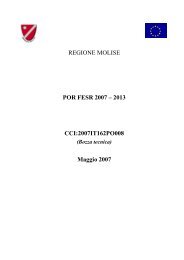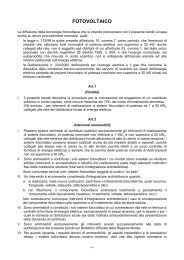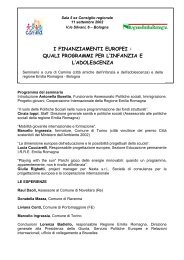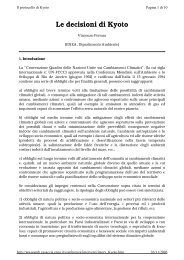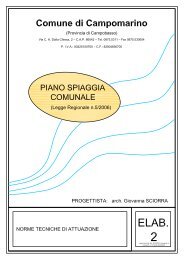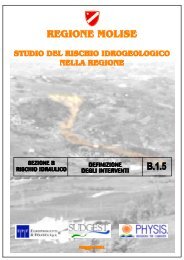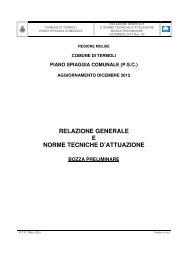Il Lago di Castel San Vincenzo e l'antica Terra ... - Regione Molise
Il Lago di Castel San Vincenzo e l'antica Terra ... - Regione Molise
Il Lago di Castel San Vincenzo e l'antica Terra ... - Regione Molise
Create successful ePaper yourself
Turn your PDF publications into a flip-book with our unique Google optimized e-Paper software.
The second phase or that of <strong>San</strong> <strong>Vincenzo</strong> Maggiore<br />
(9th-12th centuries AD)<br />
Towards the end of the eighth century <strong>San</strong> <strong>Vincenzo</strong> appeared on the scene among the<br />
Bene<strong>di</strong>ctine abbeys sustained by Charlemagne in Europe. The European tendency towards<br />
analogous Carolingian abbeys on the southern border of the Frankish empire came<br />
to a close and the abbey received privileges from the emperor in 787 AD, becoming a sort<br />
of outpost for the Frankish empire on the Me<strong>di</strong>terranean Sea, an irra<strong>di</strong>ation point for the<br />
Carolingian renovatio towards the Byzantines and Lombards in the South. Functioning<br />
as a symbol of religious and imperial power created the problem of the new monastery,<br />
which was built next to the first, with avantgarde architecture and decoration: a large<br />
church, measuring 68 meters by 28, with three naves <strong>di</strong>vided by columns (16 for each<br />
part) that came from an ancient temple in Campania, pavements made from sheets of<br />
white marble that contained <strong>di</strong>fferent types of geometric designs, a crypt similar to that of<br />
St. Peter's in Rome and frescoed walls. QUEQUE VIDES, OSPES, PENDENCIA<br />
CELSA, VEL IMA, VIR DOMINI IOSUE STRUXIT CUM FRATRIBUS UNA is written<br />
on the façade. (Everything you see, foreigner, which rises up from low to high,<br />
was built by a man of God, Giosuè, together with his brothers). The frescoes decorated<br />
the entire monastery, although there is little remaining evidence which includes the<br />
Crypt of Epifanio in which the pictorial cycle that covers both the walls and the vault is<br />
dominated by scenes of the Virgin, from the Annunciation to the Maternity, to the figure<br />
of the Queen depicted on the vault next to her son, Jesus Christ. A fundamental chapter,<br />
that of <strong>San</strong> <strong>Vincenzo</strong>'s painting, inevitable in Europe's art history in the early Middle<br />
Ages. The old monastery was transformed in a reception centre for the upper classes and<br />
connected to the new monastery with porticoes. Today the complete and original pavements<br />
are still visible in the refectory, where hundreds of monks had their meals, based on<br />
vegetables, fish and fruit, grains (emmer, durum wheat and orzo), white meat, legumes<br />
(lentils, beans and tick-beans: broad bean soup with pig lard was often eaten in winter).<br />
The workshops were located next to the monastery: and other precious objects made with<br />
French cloisonné enamel, the first example in the Mezzogiorno after those of the <strong>San</strong>cta<br />
<strong>San</strong>ctorum in Rome and <strong>San</strong>t’Ambrogio in Milan. A real monastic city, that of <strong>San</strong> <strong>Vincenzo</strong><br />
al Volturno, with a landed property that exceeded 450 square kilometres and covered<br />
various regions, from Campania to Puglia, Abruzzo and Lazio. The monastery underwent<br />
its first moment of peril when, in 860 AD, the Saracens arrived, then appeased with<br />
3,000 gold coins. The raid reoccurred in 881 AD and included<br />
Sotto: Cripta anulare <strong>di</strong><br />
S. <strong>Vincenzo</strong> Maggiore.<br />
(da R. Hogdes)<br />
<strong>San</strong> <strong>Vincenzo</strong> al Volturno - 35<br />
looting, the death of hundreds of monks; those who managed to<br />
escape then fled to Capua. The Arab’s second attack was<br />
sustained by the duke and bishop of Naples, Atanasio II, warned<br />
twice by the Pope to stop all contractual relations with the<br />
infidels.



